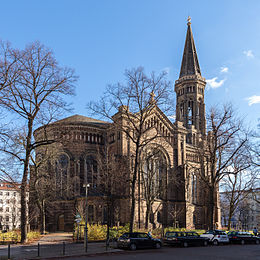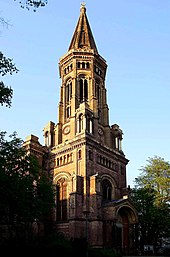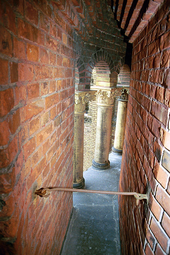Zionskirche (Berlin)
The Zionskirche is a Protestant church in the Rosenthaler Vorstadt in the Berlin district of Mitte in the district of the same name . It belongs to the Evangelical Church Community am Weinberg in the church district of Berlin Stadtmitte .
It was consecrated in 1873 in what was then the north of the city as a church of a subsidiary of the St. Elisabeth congregation. The architect of the building, donated as a votive church by the Prussian king and later German Kaiser Wilhelm I , is August Orth . The church gained importance, among other things, as the place of activity of Dietrich Bonhoeffer , who was active here as a pastor . Shortly before the end of the GDR , the Zionskirche was a center of the opposition with the church from below and the samizdat magazine Umweltblätter .
Location and urban environment
The Zionskirche stands in the middle of the Zionskirchplatz in the north of the Berlin district of Mitte in the Rosenthaler Vorstadt. It was built on the vineyard, a 52 meter high hill, one of the highest points in Berlin at that time. The 67 meter high tower stands exactly at the intersection of Zionskirchstrasse and Griebenowstrasse and, thanks to its height, also serves as an orientation and viewing point.
The urban planning function on a pentagonal square at the intersection of three streets was so important for the architect Orth that the church was not, as usual, geosted . The choir is therefore not oriented to the east, but points to the north.
history
Out of gratitude for having escaped an assassination attempt in Baden-Baden , the then King and later Emperor Wilhelm I donated 10,000 Reichstaler in 1861 for the construction of a church in what was then still part of the St. Elisabeth community , but in the course of the Construction of the Wilhelminischer Ring already densely populated area. After some disputes between the Berlin Consistory and the Berlin Magistrate, construction began in 1866. Due to a lack of funds, construction work was suspended from the end of 1868, but a further foundation by the king enabled the construction work to be completed in 1872. The church is built in the neo-Romanesque style, as a brick - terracotta building in the style of Berlin historicism with yellow facing stones from the cement and pottery factory Hermsdorf . It had 1,424 seats, 562 of them on the gallery. The construction costs (excluding the property and site management ) were 373,364 marks (adjusted for purchasing power in today's currency: around 2.78 million euros).
On March 2, 1873, the Zionskirche was inaugurated in the presence of the emperor by general superintendent Bruno Brückner . The first decades of the parish were marked by fierce conflicts between the conservative pastor Julius Kraft and the liberally dominated parish council ("Kampf in Zion").
In the Second World War , the church roof, altar, choir window and the Sauer organ were destroyed. But it wasn't just the Allied air raids on Berlin in November 1943 that caused the church to suffer additional damage in the cold post-war winters. The number of break-ins quickly became untenable, because when looking for firewood, some Berliners did not stop at the pews. So in 1946 the community decided to wall up the lower windows.
Until 1953 the church was poorly restored and renovated in the 1960s in the barren style of the time with latex paint and partly also rebuilt. The decay began again when damage to the heating and roof occurred in the 1970s and was not repaired.
It wasn't until 1988 that the roof and tower repairs began. After the German reunification and a historic preservation study of the original Innenausmalung in the altar area 1992, a year began full tower and roof renovation and progressively later restoration of the exterior facade. The bells were hung in the tower again and the badly broken windows were emergency glazed. In 2002 the walled up windows were opened again.
The interior has also been gradually renovated since autumn 2009. By 2015, over three million euros are to be spent on this. But even in July 2011, the poor condition of the interior was heavily criticized because of its historical significance.
Dietrich Bonhoeffer at the Zion Church
At the age of 25, Dietrich Bonhoeffer took over as town synodal vicar in 1931, a confirmation group in the Zion congregation that was considered difficult. The work in this socially problematic area had a lasting impact on the professor's son, who came from a good family. After 1933 he joined the Confessing Church and the resistance . Bonhoeffer was executed in Flossenbürg concentration camp in 1945 . Since 1997 there has been a bronze monument to Dietrich Bonhoeffer in front of the west side of the church, which was created in 1988 by the sculptor Karl Biedermann . A second version of this bronze torso has stood in front of the Elisabeth Church in Wroclaw since 1999 .
Opposition groups
Since 1986 the Zion Church Community has offered space for opposition groups such as the “Peace and Environment Circle in the Zion Community”. Pastor Hans Simon provided the group that published the samizdat publication Umweltblätter with his own basement, which was used as a library, event and printing room. Vigils and other protests against a house search and arrests in the environmental library located there on the night of November 25, 1987 made the church's resistance to the GDR regime known in the West as well.
Skinhead robbery 1987
On October 17, 1987 at 10 p.m. the almost 2000 visitors to an unofficial concert by the West Berlin band Element of Crime (the opening act was the GDR punk band Die Firma ) were attacked by around 30 skinheads from the right-wing scene in the GDR and some were seriously injured. This process happened under the eyes of the People's Police , who observed the church at the time in question, but did not intervene despite calls for help. After initially hesitant legal proceedings and mild penalties, there were protests even in the official GDR press. In the appeal hearing, sentences of between 18 months and four years were then imposed. Proper show trials to emphasize the anti-fascism of the GDR, to deter and maintain the reputation abroad (especially in the Federal Republic ) were held with excessive penalties. In advance, language regulations were made to play down the problem. Most of the convictions related to paragraphs 215 and 220 of the GDR criminal law, which related to the generalizing facts of hooliganism and public degradation.
While West Berlin right-wing extremists were assumed to be responsible for the violent attack in public, the incident was also the trigger for internal reflection among the political leadership at the time about right-wing youth in the GDR. However, no search was made for the causes, but only for methods to prevent an increased (public) occurrence. The Ministry for State Security (MfS) commissioned a study that dealt with this problem, the results of which, however, remained under wraps. In addition, the MfS carried out more and more observations on right-wing extremist groups and tried to break them up by smuggling in unofficial employees. The People's Police were also involved in carrying out these measures.
Sightseeing
The Zionskirche is open to visitors all year round, with the exception of January. The tower can be climbed from 12 noon on Sundays. The viewing platform is located on the clock level at 22 meters height of the tower and offers a good view over Berlin in three directions. In the tower itself you can see the vaulted ceiling of the interior from above.
A colony of bees lives in the clock level of the tower . From this the "Zion honey" is produced. This can be tried and bought during the viewing hours - if available.
literature
- Ulrich Mayer: The beginnings of the Zion Church in Berlin. An example of the emergence of parishes in large cities in the 19th century. Bielefeld 1988.
- August Location: The Zionskirche in Berlin. Ernst & Korn, Berlin 1874.
- Frank Neubacher: Youth and right-wing extremism in East Germany - before and after the turnaround . Bonn 1994.
- Harry Waibel : Right-wing extremism in the GDR until 1989. Cologne 1996.
Web links
- Entry in the Berlin State Monument List with further information
- Website of the city of Berlin: Zionskirche
- The Am Weinberg community on the Internet
- Website of the Förderverein Zionskirche e. V. in Berlin
- The organ of the Zionskirche at that time in the free organ database Organ index
Individual evidence
-
^ August Orth: The Zionskirche in Berlin. In: Zeitschrift für Bauwesen , 23rd Jg. 1873, p. 106. ( tu-cottbus.de ( Memento of the original from 7th April 2014 in the Internet Archive ) Info: The archive link was inserted automatically and has not yet been checked. Please check the original - and archive link according to the instructions and then remove this note. [PDF; 38 MB]) According to August Orth, the church stands on one of the highest points in Berlin at that time. At the time the church was built, Berlin not only included the area in front of the Rosenthaler Tor , but also z. B. also the area in front of the Prenzlauer Tor , already since 1841. Behind this gate there was the Windmühlenberg, which is located considerably higher than the hill on which the Zionskirche was built. Likewise, the natural elevation of Kreuzberg belonged to Berlin (as early as 1861), which is also higher. See also list of surveys in Berlin and Leopold Kraatz: Topographic map of the area around Berlin with the city limits of Berlin drawn. 1871
- ^ Karl Friedrich Endell, Walter Frommann: Statistical evidence concerning the Prussian state buildings completed and accounted for in the years 1871 to 1880 inclusive . In: Supplement to Zeitschrift für Bauwesen , 33rd year 1883, urn : nbn: de: kobv: 109-opus-88886 , Table I, entry no. 96, pp. 20–21.
- ^ Project: Construction site Zion. rundfunk.evangelisch.de, September 2010, accessed on July 3, 2011 .
- ↑ Michael Wolffsohn : A place of memory degenerates. In: Der Tagesspiegel . July 1, 2011, accessed July 3, 2011 .
- ↑ zion 86 photos, videos, documents and eyewitness interviews on jugendopposition.de ( Federal Agency for Civic Education / Robert Havemann-Gesellschaft e. V.)
- ^ BStU information on the skinhead attack
- ↑ Beekeeping at the Zionskirche. Retrieved January 29, 2018 .
Coordinates: 52 ° 32 ′ 5.1 " N , 13 ° 24 ′ 13.7" E






